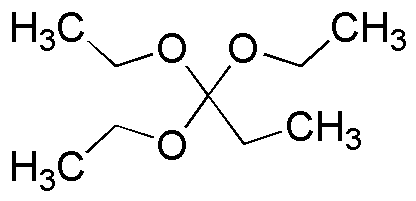Triethyl orthopropionate is widely utilized in research focused on:
- Flavor and Fragrance Industry: This compound serves as a key ingredient in the formulation of various flavors and fragrances, providing a fruity note that enhances products such as perfumes and food flavorings.
- Solvent Applications: It acts as an effective solvent in the production of coatings, inks, and adhesives, offering excellent solvency properties that improve the performance of these materials.
- Synthesis of Esters: Triethyl orthopropionate is used in organic synthesis as a reagent for esterification reactions, allowing chemists to create a wide range of esters for pharmaceuticals and agrochemicals.
- Polymer Production: It plays a role in the production of specialty polymers, contributing to the development of materials with desirable properties for applications in packaging and automotive industries.
- Research and Development: In academic and industrial research, it is utilized as a building block for developing new chemical compounds, enabling advancements in various fields such as materials science and medicinal chemistry.
Informations générales
Propriétés
Sécurité et réglementation
Applications
Triethyl orthopropionate is widely utilized in research focused on:
- Flavor and Fragrance Industry: This compound serves as a key ingredient in the formulation of various flavors and fragrances, providing a fruity note that enhances products such as perfumes and food flavorings.
- Solvent Applications: It acts as an effective solvent in the production of coatings, inks, and adhesives, offering excellent solvency properties that improve the performance of these materials.
- Synthesis of Esters: Triethyl orthopropionate is used in organic synthesis as a reagent for esterification reactions, allowing chemists to create a wide range of esters for pharmaceuticals and agrochemicals.
- Polymer Production: It plays a role in the production of specialty polymers, contributing to the development of materials with desirable properties for applications in packaging and automotive industries.
- Research and Development: In academic and industrial research, it is utilized as a building block for developing new chemical compounds, enabling advancements in various fields such as materials science and medicinal chemistry.
Documents
Fiches de données de sécurité (FDS)
La FDS fournit des informations de sécurité complètes sur la manipulation, le stockage et l’élimination du produit.
Spécifications du produit (PS)
Le PS fournit une description complète des propriétés du produit, notamment sa composition chimique, son état physique, sa pureté et les exigences de stockage. Il détaille également les plages de qualité acceptables et les applications prévues du produit.
Certificats d'analyse (COA)
Recherchez des certificats d'analyse (COA) en saisissant le numéro de lot du produit. Les numéros de lot et de lot se trouvent sur l'étiquette d'un produit, après les mots « Lot » ou « Lot de fabrication ».
Numéro de catalogue
Numéro de lot/série
Certificats d'origine (COO)
Ce certificat d'exploitation confirme le pays dans lequel le produit a été fabriqué, et détaille également les matériaux et composants utilisés et s'il est issu de sources naturelles, synthétiques ou autres sources spécifiques. Ce certificat peut être requis pour les douanes, le commerce et la conformité réglementaire.
Numéro de catalogue
Numéro de lot/série
Fiches de données de sécurité (FDS)
La FDS fournit des informations de sécurité complètes sur la manipulation, le stockage et l’élimination du produit.
DownloadSpécifications du produit (PS)
Le PS fournit une description complète des propriétés du produit, notamment sa composition chimique, son état physique, sa pureté et les exigences de stockage. Il détaille également les plages de qualité acceptables et les applications prévues du produit.
DownloadCertificats d'analyse (COA)
Recherchez des certificats d'analyse (COA) en saisissant le numéro de lot du produit. Les numéros de lot et de lot se trouvent sur l'étiquette d'un produit, après les mots « Lot » ou « Lot de fabrication ».
Numéro de catalogue
Numéro de lot/série
Certificats d'origine (COO)
Ce certificat d'exploitation confirme le pays dans lequel le produit a été fabriqué, et détaille également les matériaux et composants utilisés et s'il est issu de sources naturelles, synthétiques ou autres sources spécifiques. Ce certificat peut être requis pour les douanes, le commerce et la conformité réglementaire.


